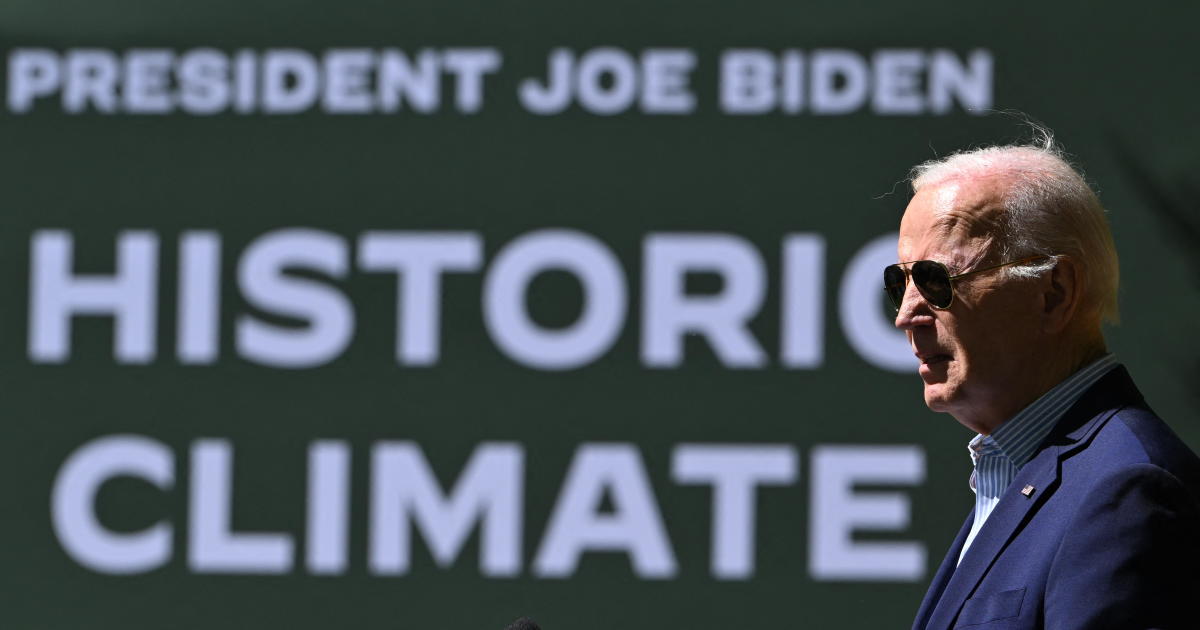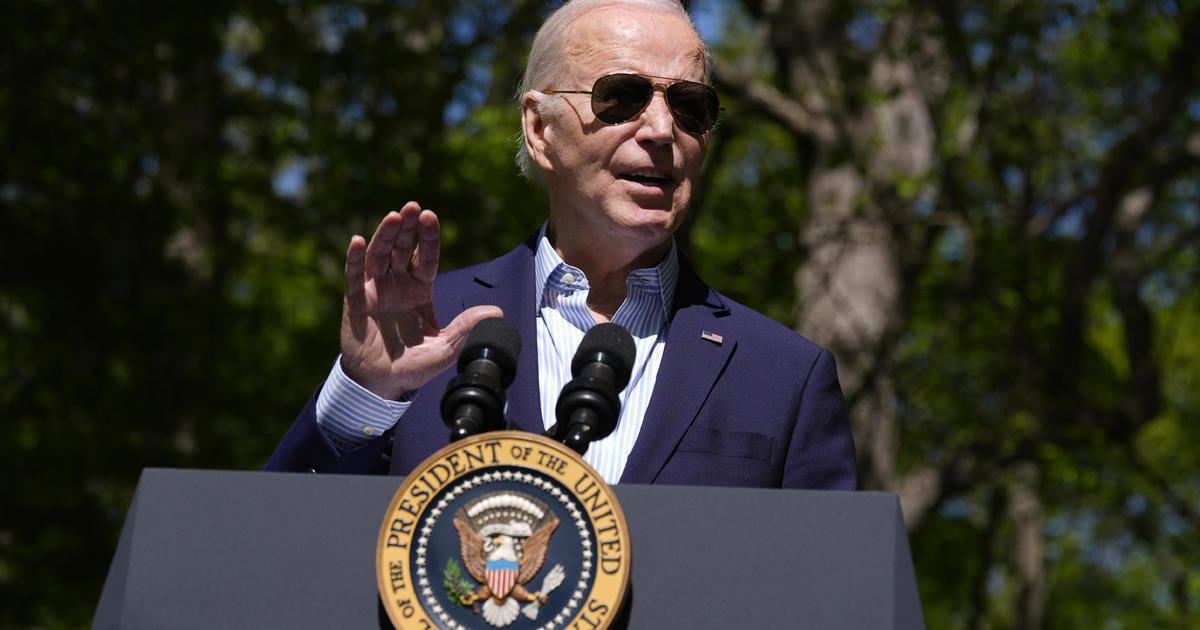Climate experts and activists applaud Biden's Build Back Better climate agenda: "This is a game changer"
The White House's revamped Build Back Better framework contains $555 billion to combat climate change — an amount President Biden has called the "most significant investment to deal with the climate crisis ever." But would the framework's impact be as significant as its size?
Congress passed the first part of Mr. Biden's domestic agenda, the bipartisan $1.2 trillion infrastructure bill, late Friday night. And while that bill does set the stage for actions that could help curb climate change, including putting billions toward
electric vehicles, the majority of the climate action on the table lies within Mr. Biden's $1.75 trillion Build Back Better agenda, which is still being negotiated.
Climate experts and activists have expressed excitement for the framework and say that while not perfect, it can substantially help the U.S. tackle the climate crisis.
"It makes dramatic new investments in fighting climate change," said Elizabeth Gore, senior vice president of political affairs for the Environmental Defense Fund, a non-profit group. "And these are transformational changes that would really, dramatically reduce emissions and really move us in the direction of the change that we need to reach the clean energy economy that we need."
Gore said the thoroughness of the framework has garnered a lot of support from the environmental community, and that she and many of her colleagues are excited to see what it could mean for the coming decades.
"I'm very optimistic," she said. "The environmental community, it doesn't always agree on everything, but this has unified our community in a way that we haven't seen in a long time."
Environmental scientist Deborah Brosnan called it "a huge win for America."
"This is a game changer, and it's almost like it takes us from the 20th century into the 21st century, heading for the 22nd century," she said.
Here is some of what the framework promises to do, and what experts have to say about it.
Cutting greenhouse gas emissions
As it stands, the Build Back Better framework would cut more than a gigaton of greenhouse gas emissions by 2030, an amount that is between 50 and 52% lower than 2005 levels, according to the White House. Cutting these emissions, as repeatedly stated by the United Nations, is essential in limiting the amount the planet warms, as greenhouse gases trap heat in the atmosphere.
The framework includes a waste emissions charge that would fine oil and gas producers that exceed an "applicable waste emissions threshold."
But what really stuck out to Gore and others are the clean energy tax provisions included in the framework.
The tax credits, amounting to roughly $320 billion, are outlined as lasting for 10 years and would help both people and companies invest in and transition to clean energy solutions, including purchasing electric cars, installing solar panels, and manufacturing wind turbines.
Gore specifically referenced the electric vehicle provisions, as the framework includes whole-picture incentives related to the manufacturing and purchase of electric vehicles, as well as of charging stations.
"It's trying to capture that whole sort of waterfront of issues that all contribute towards moving us towards electric vehicles," she said. "... And those pieces reinforce each other in a way that make them impactful."
Lindsey Griffith, federal policy director for the Clean Air Task Force, an environmental organization, told CBS News that the clean energy tax credits will get the to U.S. reduce emissions by nearly 70% in the energy sector, which is the nation's second-largest emitting sector.
"What we see in our modeling is that that will lead to a massive deployment of renewables in this decade," Griffith told CBS News, "and also to start to incentivize some of those firm zero-carbon technologies that we're going to need to complement their deployment."
Those provisions, Gore said, are things that would have a "pretty immediate impact."
"Those are policies that can put market signals out that can drive change in the short term," she said, noting that the framework will also ensure that many of the policies, including the tax provisions, are in place for a decade.
"That means that people who finance projects have some certainty," she said. "It's not the short-term, sort of herky jerky approach that we've seen to these tax provisions in the past, but really provides that long-range thinking so that you can start to make those investments and transform the economy."
A push for environmental justice
Perhaps one of the most notable aspects of the framework is an investment in communities that have had to bear the brunt of climate-related issues.
As part of President Biden's Justice40 initiative, the framework outlines a new Clean Energy and Sustainability Accelerator that will invest in environmental justice projects. Forty percent of the benefits of the investments will go to disadvantaged communities, according to a White House fact sheet. Such programs include flood mitigation assistance for areas and tribes that repeatedly get flooded, a drinking water revolving fund to improve drinking water quality, and guaranteed loan financing and grants for agricultural producers and rural small businesses that move to renewable energy systems or make energy-efficient improvements.
The numerous credit provisions in the bill also include rebate proposals to better assist homeowners in lower-income communities make changes that weatherize their homes and make them more energy-efficient.
The framework also provides grants to entities that develop programs to help low-income communities, or those that are experiencing or at-risk of experiencing "adverse health and environmental conditions." Native and Indigenous groups would be able to receive millions in aid and grants to help tribes develop climate resilience plans and recover from extreme weather events.
Gore said the environmental justice elements in the package are "strong" and make Build Back Better a "better package overall."
"There has been a really fundamental shift within the environmental community, within policymakers, that we need to have environmental justice be foundational and not something that gets tacked on at the end," she said.
Other aspects of the Build Back Better plan tackle poverty, health care inequities, affordable housing, education and child care.
"This package includes a lot of provisions that put environmental justice front and center. ... This is an area that has been too long ignored or underrepresented in the debate of environmental policy, and this administration and I think a lot of other stakeholders have elevated it."
Investing in land and its caretakers
The framework includes $105 billion of resilience investments that focus on addressing and preparing for extreme weather events, including wildfires, droughts and hurricanes. The impact of such events on communities, as well as on forestry, wetlands and agriculture, is accounted for in the framework.
The framework also dedicates money for farmers and ranchers, allocating billions in appropriations for farm loan borrowers and for farmers and ranchers who take part in agricultural conservation practices or enhancements.
Climate change research is also getting a boost under the bill, with the Environmental Protection Agency set to receive $100 million until September 30, 2026 for research related to climate change mitigation, adaptation and resilience.
For environmental scientist Deborah Brosnan, who primarily works in environmental risk reduction, what really stands out is the emphasis on resilience and helping agricultural workers.
"A lot of farmers are finding that the crops they used to grow, they can't grow anymore, because of climate change," she said, adding that even the food supply chain has changed over the past few years as climate change accelerates. "Crops are changing, we're going to get used to a whole new order of things. ... We're going to see this whole new world."
And, she said, the resilience aspects of the framework are a vital component to an ever-warming planet, as they "will avert a lot of human suffering and distress."
"I think that sends a very positive message on climate, to include resilience and to help communities that are dependent on ecosystems and landscapes that are changing," she said, particularly because she does not believe the world will be able to stay under the 1.5 degree Celsius threshold of warming, based on what she saw at the COP26 summit.
"I think countries are trying to do the best they can, given the political systems that they're working under," she said. "... I think we're likely to blow beyond 1.5, to be honest, but as we get closer and closer, I think the urgency is going to get greater and the countries and businesses will start to respond stronger."
The fate of the bill remains to be seen. If it passes, the experts CBS News spoke with said it will be crucial to ensure that all of the plans outlined in the framework are effectively implemented, and soon. And whether it passes or not, they said, there is still more work to do in tackling the crisis.
"We're still going to have a lot more to do, this year, next year. Hopefully every year we'll get another chance to do more in the climate policy space," Griffith said. "But we can't wait."





